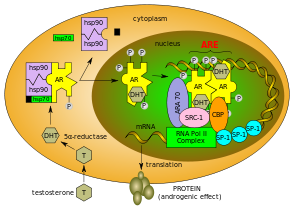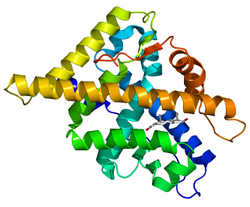
Back مستقبلات الأندروجين Arabic Androgeni receptor BS Receptor androgènic Catalan وەرگری ئەندرۆجین CKB Androgenrezeptor German Receptor androgénico Spanish گیرنده آندروژن Persian Androgeenireseptori Finnish Récepteur des androgènes French Receptor de andróxenos Galician
| Androgen_recep | |||||||||
|---|---|---|---|---|---|---|---|---|---|
 crystal structure of the human androgen receptor ligand binding domain bound with an androgen receptor nh2-terminal peptide, ar20-30, and r1881 | |||||||||
| Identifiers | |||||||||
| Symbol | Androgen_recep | ||||||||
| Pfam | PF02166 | ||||||||
| InterPro | IPR001103 | ||||||||
| |||||||||

The androgen receptor (AR), also known as NR3C4 (nuclear receptor subfamily 3, group C, member 4), is a type of nuclear receptor[9] that is activated by binding any of the androgenic hormones, including testosterone and dihydrotestosterone,[10] in the cytoplasm and then translocating into the nucleus. The androgen receptor is most closely related to the progesterone receptor, and progestins in higher dosages can block the androgen receptor.[11][12]
The main function of the androgen receptor is as a DNA-binding transcription factor that regulates gene expression;[13] however, the androgen receptor has other functions as well.[14] Androgen-regulated genes are critical for the development and maintenance of the male sexual phenotype.
- ^ a b c GRCh38: Ensembl release 89: ENSG00000169083 – Ensembl, May 2017
- ^ a b c GRCm38: Ensembl release 89: ENSMUSG00000046532 – Ensembl, May 2017
- ^ "Human PubMed Reference:". National Center for Biotechnology Information, U.S. National Library of Medicine.
- ^ "Mouse PubMed Reference:". National Center for Biotechnology Information, U.S. National Library of Medicine.
- ^ Quigley CA, De Bellis A, Marschke KB, el-Awady MK, Wilson EM, French FS (June 1995). "Androgen receptor defects: historical, clinical, and molecular perspectives". Endocrine Reviews. 16 (3): 271–321. doi:10.1210/edrv-16-3-271. PMID 7671849.
- ^ Gottlieb B, Lombroso R, Beitel LK, Trifiro MA (January 2005). "Molecular pathology of the androgen receptor in male (in)fertility". Reproductive Biomedicine Online. 10 (1): 42–8. doi:10.1016/S1472-6483(10)60802-4. PMID 15705293.
- ^ Choong CS, Wilson EM (December 1998). "Trinucleotide repeats in the human androgen receptor: a molecular basis for disease". Journal of Molecular Endocrinology. 21 (3): 235–57. doi:10.1677/jme.0.0210235. PMID 9845666.
- ^ Meehan KL, Sadar MD (May 2003). "Androgens and androgen receptor in prostate and ovarian malignancies". Frontiers in Bioscience. 8 (1–3): d780–800. doi:10.2741/1063. PMID 12700055.
- ^ Lu NZ, Wardell SE, Burnstein KL, Defranco D, Fuller PJ, Giguere V, et al. (December 2006). "International Union of Pharmacology. LXV. The pharmacology and classification of the nuclear receptor superfamily: glucocorticoid, mineralocorticoid, progesterone, and androgen receptors". Pharmacological Reviews. 58 (4): 782–97. doi:10.1124/pr.58.4.9. PMID 17132855. S2CID 28626145.
- ^ Roy AK, Lavrovsky Y, Song CS, Chen S, Jung MH, Velu NK, et al. (1999). Regulation of androgen action. Vitamins & Hormones. Vol. 55. Elsevier. pp. 309–52. doi:10.1016/S0083-6729(08)60938-3. ISBN 978-0-12-709855-5. PMID 9949684.
- ^ Bardin CW, Brown T, Isomaa VV, Jänne OA (1983). "Progestins can mimic, inhibit and potentiate the actions of androgens". Pharmacology & Therapeutics. 23 (3): 443–59. doi:10.1016/0163-7258(83)90023-2. PMID 6371845.
- ^ Raudrant D, Rabe T (2003). "Progestogens with antiandrogenic properties". Drugs. 63 (5): 463–92. doi:10.2165/00003495-200363050-00003. PMID 12600226. S2CID 28436828.
- ^ Mooradian AD, Morley JE, Korenman SG (February 1987). "Biological actions of androgens". Endocrine Reviews. 8 (1): 1–28. doi:10.1210/edrv-8-1-1. PMID 3549275.
- ^ Heinlein CA, Chang C (October 2002). "The roles of androgen receptors and androgen-binding proteins in nongenomic androgen actions". Molecular Endocrinology. 16 (10): 2181–7. doi:10.1210/me.2002-0070. PMID 12351684.






